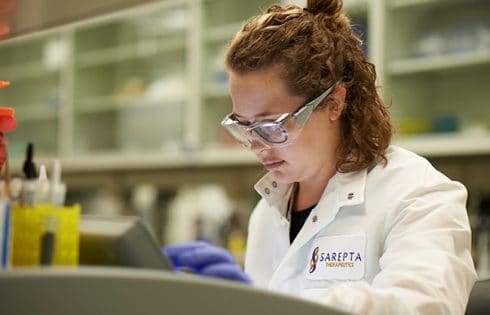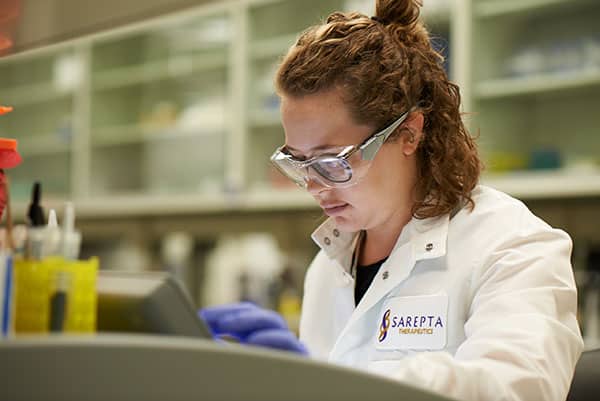
Even as investors punished Sarepta Therapeutics (NASDAQ: SRPT) after it disclosed the death of a patient treated with its Duchenne muscular dystrophy (DMD) gene therapy Elevidys® (delandistrogene moxeparvovec-rokl) this past week, analysts have generally remained bullish, taking a more favorable view of the company—which explains why the stock selloff wasn’t any worse, and why at deadline not a single analyst had downgraded Sarepta’s shares.
Sarepta shares finished the week tumbling 27% from a high of $101.35 on March 17. The following day, Sarepta issued a statement acknowledging the sudden death of a 16-year-old male with DMD of acute liver failure after being treated with Elevidys. The death was the first ever reported among the 800 patients who have taken the drug in clinical trials or as a prescribed therapy, Sarepta noted.
From there, Sarepta shares yo-yoed, starting with a 27% plunge to $73.54 Tuesday, bouncing back 9% to $79.97 Wednesday, then giving up that gain the following day, sliding 8% to $73.45. Sarepta shares stayed nearly flat on Friday, edging up 0.88% to $74.10.
Why didn’t analysts share the same fear that gripped investors about Sarepta stock?
Several reasons have emerged in the research notes of analysts following up on the death. One is the known risk of acute liver injury associated with adeno-associated virus vector (AAV)-based gene therapies like Elevidys—a risk that calls for more careful monitoring, Jefferies equity analyst Andrew Tsai and Ritu Baral, a managing director and senior biotech analyst with TD Cowen, both observed.
Elevidys is indicated for individuals at least four years old to treat DMD in patients who are ambulatory and have a confirmed mutation in the DMD gene, as well as for patients who are non-ambulatory and have a confirmed mutation in the DMD gene—the latter under an accelerated approval based on expression of Elevidys microdystrophin, which may hinge upon confirmatory studies.
“This could give physicians further pause when considering whether to start a patient on Elevidys, especially considering perceptions of relatively modest clinical benefits,” Brian Abrahams, MD, managing director and co-head of biotechnology research with RBC Capital Markets, wrote.
In its statement, Sarepta disclosed that the patient was found through testing to have had a recent cytomegalovirus (CMV) infection, “which was identified by the treating physician as a possible contributing factor.” CMV can infect and damage the liver, resulting in CMV hepatitis.
“Deeply saddened”
“We are deeply saddened by this patient’s death, and our profound sympathies go out to his family,” Baral wrote. “We think his CMV-confounded liver failure death underscores the careful management older Elevidys patients require in the post-treatment period.”
“We do not think this event is unique to Elevidys,” Baral added. “Rather that [the] risk [of] CMV reactivation (secondary to post-Tx steroids) and liver injury/failure is inherent to any high-dose AAV treatment, especially in older DMD patients.”
As for younger patients, Baral cited the opinion of an unnamed key opinion leader (KOL) described as specializing in orphan neuromuscular disease: “Our KOL sees no impact on his center’s Elevidys use in younger pts.”
The KOL “believes this event will have no impact on how younger patients are treated with Elevidys. Still, we believe investors were hoping for an acceleration of Elevidys growth (over current guidance) in 2025, which this event will likely prevent,” the analyst cautioned.
Sarepta previously projected 162% yearly growth for Elevidys, which would translate to about $1.33 billion in net product revenue—nearly half the company’s 2025 net product revenue guidance range of $2.9 billion to $3.1 billion, representing 70% year-over-year growth.
Baral does not expect the death to result in the revocation of Elevidys’ accelerated approval in non-ambulatory patients but cautioned: “We do think it may slow uptake in this population.”
That’s because both non-ambulatory and older patients generally weigh more than their younger and ambulatory counterparts, and thus would need larger doses of Elevidys—reflecting the longstanding issue over gene therapy dosing. Older patients also have higher morbidity, Leerink Partners analyst Joseph Schwartz noted.
“While an incredibly sad development for the young man, his family, and the DMD community, it appears that this is a unique event with a very low incidence rate. We continue to view the benefit/risk of Elevidys treatment favorably, and think the stock reaction for SRPT is overdone,” Schwartz asserted Tuesday.
“This is an overreaction”
“We think this is an overreaction and presents a buying opportunity ahead of a continued strong Elevidys launch,” Schwartz wrote. “Although we acknowledge that such severe side effects associated with mortality can certainly be alarming and cause the community to question the risk/benefit of treating older patients, we believe that the very low overall incidence which we estimate at less than 0.125% based on aggregate exposure to date is encouraging.”
That incidence is still under 1%, he added, when the death is placed in the context of the more than 100 non-ambulatory patients treated with Elevidys since June 2024, when the FDA expanded its approval of the gene therapy to include non-ambulatory patients ages four and up with a confirmed mutation in the DMD gene (from ambulatory children ages 4-5).
Schwartz maintained Leerink’s “Outperform” rating on Sarepta stock.
Sarepta finished 2024 with GAAP net income of $235.2 million on total revenue that jumped 53% year-over-year to $1.902 billion, swinging from a net loss of $536 million on total revenue of $1.243 billion.
A key component of those results was Elevidys, which generated $820.8 million in net product revenue last year, of which $384.2 million came during the fourth quarter. Outside the United States, rights to Elevidys are held by Roche, which generated $16.8 million in 2024 royalty revenue (including $4.9 million in Q4) on sales of the gene therapy.
“Most successful” launch
“After obtaining a broad label for our gene therapy Elevidys covering the vast majority of Duchenne patients, we had the most successful gene therapy launch in history,” Sarepta president and CEO Doug Ingram said in a statement.
While no analysts downgraded Sarepta stock, two lowered their 12-month price targets on the company’s shares:
- Deutsche Bank (David Hoang)—Down 24% from $105 to $80, maintaining “Sector Perform” rating.
- Scotiabank (Louise Chen)—Down 20% or $25, from $124 to $99, maintaining “Hold” rating.
“Our hearts are heavy,” Pat Fulong, president of Patient Project Muscular Dystrophy, wrote on the organization’s website. “The loss of a child is a tragedy beyond words, and our entire community grieves alongside this family and their loved ones. Let us lean on one another in this time of mourning as we grieve, seek understanding, and push forward with hope.”
Leaders and laggards
- Elevation Oncology (NASDAQ: ELEV) shares nosedived 41% from 48 cents to 28 cents Thursday after the company announced it has begun evaluating strategic options to maximize shareholder value. Elevation said it will end development of EO-3021, a Claudin 18.2 antibody-drug conjugate (ADC) that was being developed to treat advanced, unresectable, or metastatic gastric and gastroesophageal junction (GEJ) cancers. The decision followed data from the dose escalation and expansion stages of a Phase I trial in which treatment with EO-3021 as a monotherapy showed an objective response rate of 22.2% (one confirmed complete response and seven confirmed partial responses), plus a disease control rate of 72.2% among 36 evaluable patients with gastric or GEJ cancer and Claudin 18.2 in ≥20% of tumor cells at IHC 2+/3+. Elevation added it will continue to advance EO-1022, a HER3 ADC being developed to treat HER3-expressing solid tumors.
- Windtree Therapeutics (NASDAQ: WINT) shares surged 29% from $1.69 to $2.18 Thursday after the company said it entered into a license and supply agreement to become the sourcing partner for Evofem Biosciences (OTCQB: EVFM) for Evofem’s FDA-approved Phexxi® (lactic acid, citric acid, and potassium bitartrate), a first-in-class non-hormonal birth control gel. Windtree said it aims to help generate profitable revenue by contracting with Phexxi’s manufacturer to produce the gel at a cost “significantly” below the current level. Evofem will maintain ownership of Phexxi and continue to commercialize it in the United States and internationally through strategic partnerships. Windtree CEO Jed Latkin said the agreement was the company’s first step toward becoming a revenue-generating biotech.

